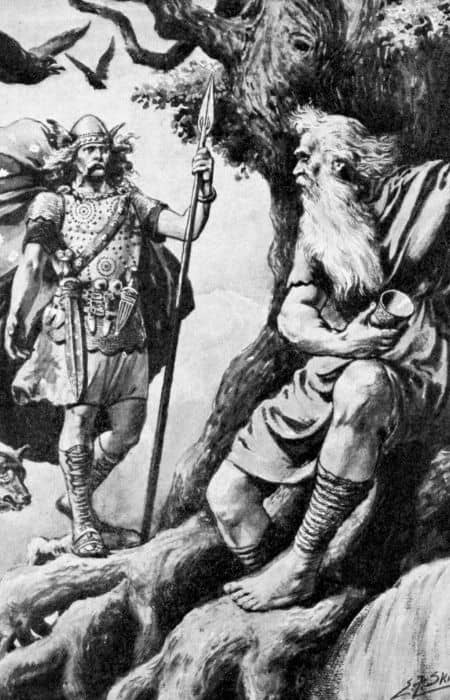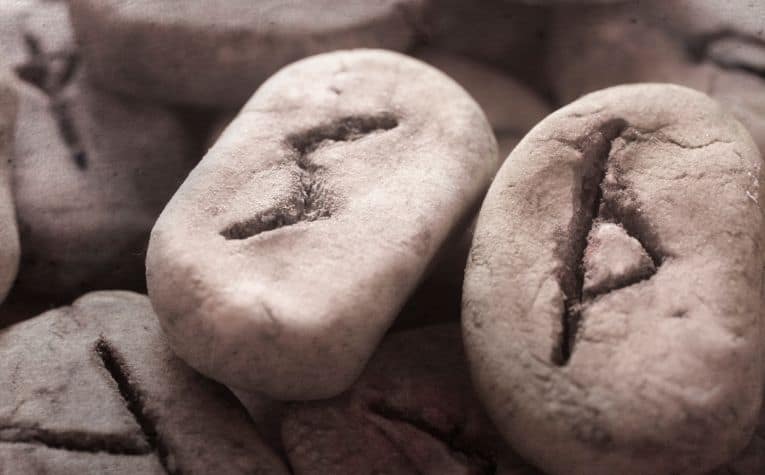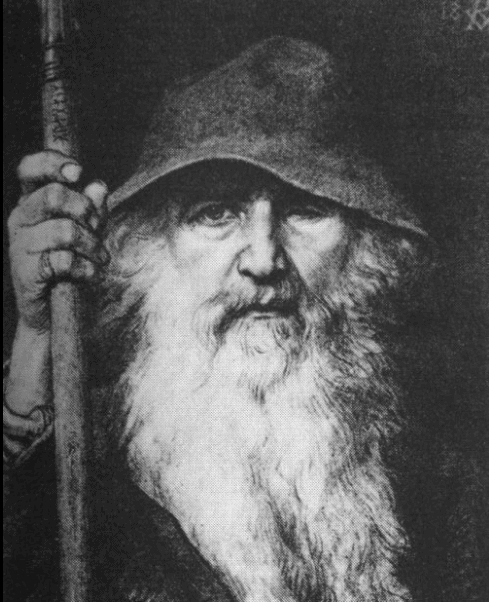When Odin and his brothers defeated the giant Ymir and birthed the cosmos, the nine realms were created, but why did they stop at this number?
While there is no clear-cut answer in any Norse stories, we do have some clue as to this choice’s significance.
Odin likely stopped at the nine realms due to the power the number nine has in Norse mythology.
Nine draws its importance from the lunar calendar, which has a cycle of 27 days, a multiple of 9. This number appears throughout Norse myths and stories.
Many cultures assign meaning to numbers, and the number nine is one of many that bear great significance in Norse mythos.
Other numbers that you might see pop up are three, seven, and eight. But out of all the sacred numbers in mythology, why nine?
Keep reading to find out the significance of the nine realms and why Odin likely chose that number.
Ever wonder why Odin is depicted with one eye? See This Is Why Odin Sacrificed His Eye to learn more.

The Significance of Odin’s 9 Realms
When Odin created the great cosmic ash tree Yggdrasil, he formed the nine realms in the branches and roots. This great tree bound all of the cosmos into one.
The importance of this tree in Norse myths and its cultural significance is linked to numbers in mythology. (Also see The Norse Tree of Life: A Fascinating Viking Symbol)
Odin likely stopped at nine to link the tree and the realms to the Germanic lunar calendar cycles.
The number 9 and 3 and 27, play a significant role in the calendar and other Norse stories.
The number bears significance because it represents the Norse people and powerful magic often associated with the gods. (Also see Valhalla vs. Asgard: What’s the Difference?)

Why Nine is Important in Norse Mythology
The number nine plays a significant role in Norse mythology. While there are a few numbers that bear significance in the lore, the number nine is seen by most to be the most important.
The number eight, for example, is important for being unlucky. It pops up over many myths to represent instability and misfortune.
Loki, the god of mischief, uses the number eight in numerous stories.
The Vikings were religious people. See Why Did the Vikings Worship Odin? to learn more.
Three plays a sacred role and can be linked to the three brothers when they created the realms.
The great tree Yggdrasil has three roots that plunge to bind the three realms: Asgard, Urd, and Niflheim. They give the tree life and connect it to Hel.
Some know nine as the greatest of all the numbers in Norse mythology. Nine represents magic and often is seen as a turning point number.
Eight often turns into nine, as bad luck turns into opportunity.
Nine is the most mentioned number and has considerable significance attached to it over many myths and stories.
The Norse people lived their lives by the lunar calendar. It provided them with timekeeping for the months and seasons and offered a connection to the cosmos and gods through the many festivals and holidays that dotted the calendar.
They likely used the lunar calendar to help them plant and harvest, mark the hunt’s start, and help guide their religious practices.
The numbers that bound the calendar, in turn, bound their lives and the stories they told about their gods.
Odin was known as more than just Odin. See Why Does Odin Have So Many Names? to learn more.
What are the 9 Realms?
The nine realms were created in two events. The first began before the dawn of time in the dark lifeless void called Ginnungagap.
This is where the first two realms were formed, Niflheim and Muspelheim. They represented darkness and light.
This land was occupied by giants; the greatest of them was Ymir. Odin and his brothers, fearing the giants and their numbers, decided to assault Ymir to end the giants’ reign.
In a bloody and intense battle, they could defeat the great Ymir, and his body was then turned into the cosmos.
His blood became the rivers, his flesh the land. His bones and teeth became the mountains and the rocks.
His hair was made into the trees and plants, and his eyelashes became one of the new realms: Midgard.
In addition to Midgard, six other realms were created. Combined with the original two, this makes for nine realms.
Interested in Norse Mythology? See 14 Great Books on Norse Mythology that explain the gods, heroes, and villains of these ancient stories of Scandinavia.

Each realm has played a unique role in Norse stories:
- Niflheim – A land of fog and mist, this realm is the darkest and coldest of them all.
- Muspelheim – This land is filled with fire and is home to the fire demons and giants.
- Asgard – The home of the gods.
- Midgard – Also known as middle earth, this land is home to humans.
- Jotunheim – Known as the home of the giants.
- Vanaheim – This land is home to the old gods, known as the Vanir.
- Alfheim – The light elves call this realm their own. They are known as guardian angels.
- Svartalfheim – This realm is home to the dwarves who live underground.
- Helheim – Hel is where the dead who died in dishonor go when they pass. It is home to thieves, murderers, and those not brave enough for Valhalla.
These nine realms cover all of the cosmos and creation. Much like other religions’ origin stories, these tales were told to connect people to their community and cultural heritage.
They are more than just stories, and certainly more than just myths. For the people that used them to explain the world, their mythos connected them to the divine: to the gods.
Other Norse Stories that Support the Importance of Nine
While the most important story that revolves around the number nine is the creation myth, the number is referenced many times in the gods’ stories.
Odin is associated with the number a few times. His ring Draupnir drips gold drops down every ninth night.
These create eight rings of equal size and weight. He also hangs upon the great tree Yggdrasil to secure the sacred runes of knowledge. He sacrificed himself and hung upon the tree for nine days.
Other famous gods have ties to the number nine. Thor, in the great battle Ragnarok, slays the serpent Jormungand and stubbles back nine steps before falling to the serpent’s poison. He then resurrects himself.
The god Hermod rode Odin’s horse Sleipnir for nine days through the dark roots of Yggdrasil towards Hel. Heimdall, the bridge Bifrost keeper that connects Asgard and Midgard, was born of nine mothers.
Nine also has cultural and historical significance in Nordic countries.
For example, Sweden used to host a great feast at the Temple of Uppsala, where they would gather and celebrate for nine days. This feast would happen every nine years.
Nine pops up in numerous areas across the lore; here are a few more significant instances of the number:
- There are nine great Lindworms.
- Baugi, the Giant, had nine Thralls who all killed themselves searching for Odin’s sharpening stone.
- In the poem Grimnismal, Odin is held by King Geirrod for eight days until he reveals his identity and defeats the King on the ninth.
- Aegir has nine daughters.
- Thrivaldi, the Giant, has nine heads.
Also, see Is Odinsleep Found In Norse Mythology? to learn more.
The 9 realms in Norse Mythology
Throughout the poems and stories of Norse mythology, the number nine plays a significant role in binding the tales to the cosmos’ greater workings.
There is no hiding the heavy-handed influence that numbers, including nine, had on the Norse people and their mythos.
When it comes to the creation myth, the origin of the cosmos, and the nine realms, Odin brought from the chaos of Ginnungagap a peaceful place for man, gods, dwarves, elves, and giants to live harmoniously.
They were all linked together by nine, the magic number that represents their pagan faith.
There is no explicit mention of why the number nine was chosen to bind the realms, but understanding how numbers play into the greater Norse lore can give us insight into why this number was chosen.
References:
[1] Source
[2] Source
[3] Source
[4] Source
[5] Source
